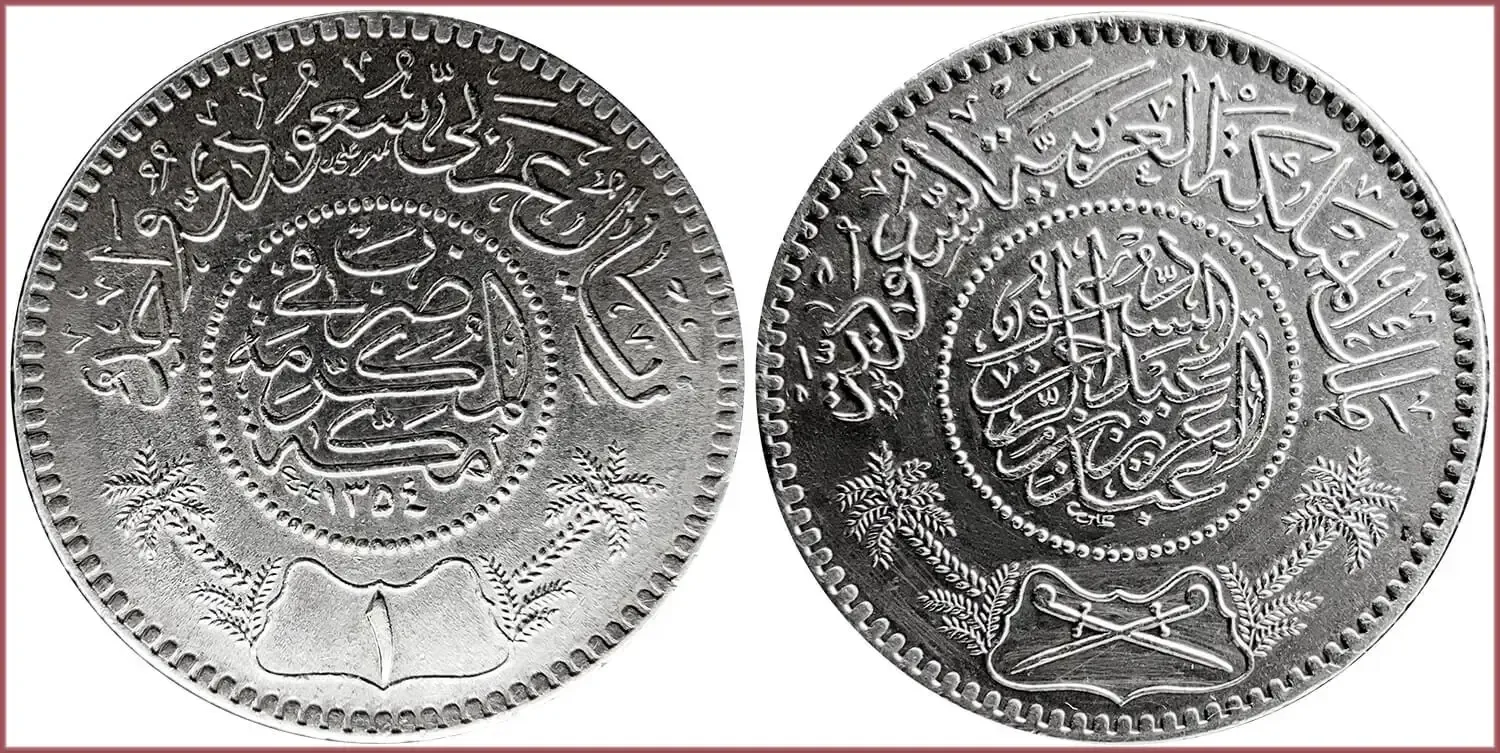RIYAL: COIN OF SAUDI ARABIA
1 riyal, 1935: Kingdom of Saudi Arabia
Date on coin: AH 1354 (AH: Latin "Anno Hegirae" — "the year of the Hijra"; Islamic calendar) = 1935 (Gregorian calendar).
Ruler: Abdulaziz bin Abdul Rahman Al Saud — founder and first King of Saudi Arabia (1932-1953); led wars for the unification of Arabia.
١: 1.
ريال عربي سعودي واحد: One Saudi Arabian riyal.
ضرب في المكرمة مكة: Struck in the city of Mecca.
١٣٥٤: 1354.
Two palm trees (both on the obverse and reverse of the coin — reminiscent of the image of a palm tree on the Emblem of Saudi Arabia).
ملك المملكة العربية السعودية: King of the Kingdom of Saudi Arabia.
عبد العزيز بن عبد الرحمن السعود: Abdulaziz bin Abdul Rahman Al Saud.
Crossed swords (reminiscent of the image of two swords on the Emblem of Saudi Arabia).
Mintage: 60.000.000.
- Silver (0.9167): 30 mm - 11.7 g
- Reference price: 20$
COIN RIYAL — WHERE & WHEN (coins catalog: by names & emitents)
- KINGDOM OF SAUDI ARABIA (1928-...): riyal = 100 halala = 20 qirsh
- STATE OF QATAR (1978-…): riyal = 100 dirham
- KINGDOM OF IRAQ (1932-...): riyal = 200 fils
- SULTANATE OF ZANZIBAR (1882): riyal = 136 pysa
- ...
RIYAL as coin name.
At the end of the 15th century, the colonial Spanish Empire began issuing a new large silver coin, worth 8 Spanish reales. Quite quickly, it spread throughout the world in an unprecedented way (first of all, of course, in the lands of Spanish possessions on several continents), becoming essentially the first in the history of international currency. In world numismatics it is known as the Spanish dollar, while in Latin America it is the peso.
This 8-real coin was also used by the states of the Arab world (Middle East Asia and Africa) for international calculations. It had such a significant impact on the formation of the monetary systems of a number of Muslim states that, starting from the end of the 19th century, local coins with derived names began to appear.
Thus, during the next century, more than a dozen Arab states began to issue money with a denomination written in Arabic as "ريال". Interestingly, in numismatic catalogs in English, one part of the names of such currencies is written as rial, while the other is riyal. There are inconclusive reports that the first variant is the Arabic reading of the term "ريال", while the second is the Persian. Be that as it may, some modern currencies are called officially as rial, and others are called as riyal.
Therefore, I decided to distinguish between the monetary denominations of rial and riyal.
Most often, riyal is called the coins of Saudi Arabia, Iraq, Qatar, Zanzibar...











